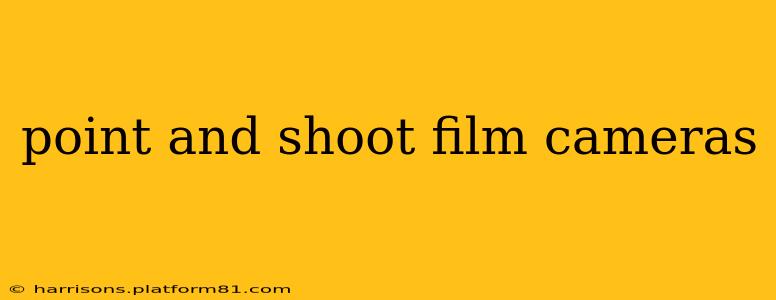The satisfying click of the shutter, the anticipation of developing the film, the unique charm of imperfections – these are just some of the reasons why point-and-shoot film cameras continue to captivate photographers. This guide delves into the world of these compact marvels, exploring their history, benefits, and how to get started. We’ll also answer some frequently asked questions to help you choose the perfect film camera for your needs.
Why Choose a Point and Shoot Film Camera in the Digital Age?
In a world dominated by digital photography, the resurgence of film cameras, particularly point-and-shoot models, is remarkable. This isn't simply nostalgia; it's a conscious choice driven by several factors:
- Unique Aesthetic: Film possesses a distinct grain and color palette that digital cameras struggle to replicate perfectly. This inherent imperfection gives film photos a timeless, almost romantic quality.
- Creative Constraints: The limited number of shots per roll and the inability to instantly review images encourage more deliberate composition and thoughtful shooting. This fosters a more mindful approach to photography.
- Tangible Results: The anticipation of waiting for your developed film adds to the excitement. Holding a physical print in your hands offers a different connection to your photographs compared to viewing them on a screen.
- Affordability: Many excellent point-and-shoot film cameras are available at surprisingly affordable prices, making them accessible to a wider audience.
What are the Different Types of Point and Shoot Film Cameras?
Point-and-shoot cameras aren't a monolithic group. They come in a wide variety of styles and features, catering to various needs and preferences. Here's a brief overview:
- Compact Cameras: These are the quintessential point-and-shoots, known for their small size and ease of use. They typically have automatic settings and are perfect for everyday snapshots.
- Advanced Compacts: These models offer more manual controls, allowing for greater creative flexibility. You might find aperture priority or shutter priority modes, or even full manual control.
- Waterproof/Shockproof Cameras: Designed for adventure, these cameras can withstand harsh conditions, making them ideal for travel or outdoor photography.
- Disposables: While technically a sub-category, disposable cameras provide an incredibly accessible and affordable entry point into film photography.
How to Choose the Right Point and Shoot Film Camera for You?
Selecting your first (or next!) point-and-shoot film camera involves considering several factors:
- Budget: Prices range widely, from incredibly affordable disposables to more expensive vintage models.
- Features: Do you need automatic settings, or do you want more manual control? Consider your photography skills and aspirations.
- Film Format: Most point-and-shoots use 35mm film, but some might use other formats like 110 or 126.
- Condition: If buying a used camera, carefully examine its condition for any signs of damage or malfunction.
What Film Should I Use with My Point and Shoot Film Camera?
Choosing the right film type can significantly impact the look and feel of your photos. Popular choices include:
- ISO 100/200: Great for well-lit conditions, these offer fine grain and good sharpness.
- ISO 400: A versatile option suitable for a wider range of lighting situations.
- Color Negative Film: A standard choice for vibrant and forgiving results.
- Black and White Film: Offers a classic look and allows for greater control in the darkroom or during post-processing.
Experimentation is key! Trying different film types will help you discover your preferences.
Where Can I Get My Film Developed?
Many drugstores still offer film developing services, although this is becoming less common. Local photo labs, online developing services, and even some camera stores are excellent alternatives. Research your local options to find a reliable and convenient service.
What are the Best Point and Shoot Film Cameras for Beginners?
Numerous excellent options exist for beginners. Researching specific models based on your budget and desired features will provide a more tailored recommendation. Online reviews and forums can provide valuable insights from other photographers.
Are Point and Shoot Film Cameras Good for Beginners?
Absolutely! Their simplicity and affordability make them ideal entry points into the world of film photography. The ease of use allows you to focus on composition and creativity without getting bogged down in complex settings.
How do I learn to use a point and shoot film camera?
The best way to learn is by doing! Start with the camera's manual (if available), experiment with different settings, and don't be afraid to make mistakes. Online resources and tutorials can provide additional guidance.
This guide provides a foundation for understanding point-and-shoot film cameras. Embrace the journey, experiment with different techniques, and enjoy the unique experience of capturing memories through this classic medium. The beautiful imperfections and unique aesthetic of film photography will undoubtedly reward your efforts.
